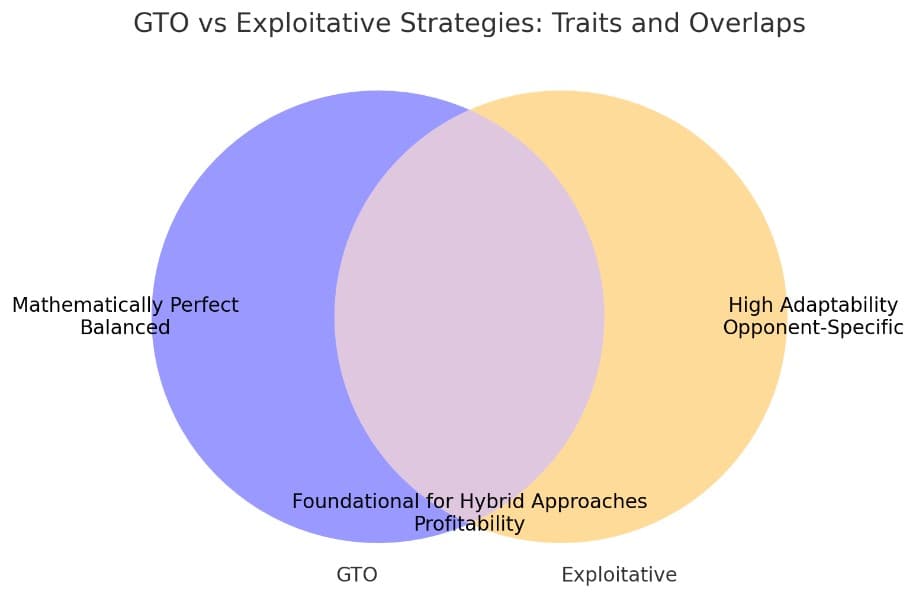
GTO vs. exploitative play: which strategy wins in poker?
Poker strategy is the domain of intellect, mathematics, and psychology. In this respect, though, it often comes down to an expert decision as to whether or not to engage an opponent in a Game Theory Optimal (GTO) manner or by applying an exploitative strategy. While there are merits and demerits on each side, the number one nugget of wisdom to take away is mastering how to wield both methods with conviction yields the greatest advantage in being developed as a versatile and successful poker player.
This paper serves as a retelling of the fundamental principles behind GTO versus exploitative play. Each one brings with it relative advantages, disadvantages, and contexts that will surely bring it into the limelight.
What is GTO?
GTO is the mathematical balance of the strategy avowed to render your choices unexploitable. It mixes between aggressive and defensive options in perfect proportions, thus ensuring that your opponent cannot make exploitative adjustments and overcome your play in the long run.
Core GTO principles:
- Balanced ranges: This means that bluffs with value bets were to be balanced in a certain proportion to not read your strategy for opponents.
- Exploitability: It is impossible for your opponents to have an edge over you in the long run, regardless of whether they fully know your strategy or not.
- Nash equilibrium: Within the framework of game theory for the GTO, it can be considered that a mathematically optimal strategy is provided for every possible play if your opponents also play perfectly.
An example of a GTO play would be a flush or missed draw on the river. In all probability, the GTO dictates a bluffing process of 33% of the missed draws and a value of 67% of the strong hands so that your oppositions do not fold too often or call too much.
Advantages of GTO
- Unexploitable: This helps one to avoid being targeted by any opponent who changes their play with an aim to exploit you.
- Consistency: The GTO allows for maximum profitability during the high-stakes games against good players.
- Mathematical precision: This is a major emotional-wreck exit strategy in logic making all game and betting decisions.
Disadvantages of GTO
- Complexity: GTO strategies involve deep study and use of advanced software tools like PioSOLVER or GTO+.
- Lower profit potential against weak players: Doesn’t maximize profit against opponents who frequently make mistakes.
What is exploitative play?
The exploitative play consists of identifying weaknesses in your opponents’ strategies and exploiting them. The idea is not to achieve balance but rather to deviate from GTO principles to capitalize on specific tendencies.
Core principles of exploitative play:
- Opponent profiling: Adjusting your strategy based on how opponents bet, call, raise, or fold.
- Maximize profit: Unbalanced situations to punish predictable or weak play.
- Dynamic adjustment: Changing tactics as you gather more info about your opponents.
Example of exploitative play:
If an opponent folds to 80% of c-bets on the flop, an exploitative player would start c-betting almost every hand and exploit the over-folding tendency.
Advantages of exploitative play
- High profit potential: Takes advantage of mistakes made by a weaker player in order to obtain maximum value.
- Flexibility: Can be adapted to different skill levels and playing styles.
- Simplicity: Generally easier to learn and apply than GTO, especially in low-stakes games.
Disadvantages of exploitative play
- Exposability: Stronger opponents can alter their strategies to exploit any imbalances in your approach.
- Inapplicability in unknown territory: If sufficient information on your opponents is unavailable, exploitative play can actually leave you in a worse position.
GTO vs. Exploitative Play: A Side-by-Side Comparison
| Feature | GTO Play | Exploitative Play |
|---|---|---|
| Approach | Balanced, unexploitable | Dynamic, opponent-specific |
| Best For | Skilled opponents or unknown fields | Weak or predictable opponents |
| Profitability | Steady but limited | High against weak players |
| Skill Requirement | Advanced | Moderate |
| Adjustment Capability | Static | Flexible |
When to use GTO vs. exploitative play
GTO Is the Better Strategy
-
Facing skilled opponents: In games with experienced players, GTO minimizes the risk of being exploited.
- Multi-table tournaments: GTO provides a solid baseline when facing a wide range of unknown opponents.
- High-stakes games: The closer the competition, the more important it is to stay balanced and unexploitable.
Exploitative play is the better strategy
- Soft low-stakes games: Most low-stakes players have clear weaknesses that can be exploited for maximum profit.
- Heads-up matches:Tart in heads-up poker. Your opponent’s tells can’t tell you anything until you’ve figured them out: You have no idea if this guy is totally terrible or good. Therefore, being aggressive can work wonders against a certain type of opponent.
- Known opponents: The data you have on an opposing player’s tendencies makes exploitative adjustments extremely potent.
Cooperation: the hybrid approach-GTO + exploitative play
The very top players will not restrict themselves to just some strategy. They rather are inclined to implement in shuffle in the hybrid strategy; that is, to switch between GTO and exploitative play intermittently in conformity with the circumstances.
An implementation of a hybrid approach:
- Start with GTO: Use GTO as your baseline strategy, especially when you have no data on your opponents.
- Scanning for weakness: Notice the players’ patterns in action to foresee exploitable tendencies.
- Adjust dynamically: Deviate from GTO when the potential rewards outweigh the risks.
- Return to balance: If opponents adjust, return to GTO to remain unexploitable.
Practical uses of GTO and exploitative play
- Online Poker
GTO bots dominate online poker, thanks to their unexploitable nature within an anonymous environment. However, crafty human players stay sharp and able to exploit amateur players.
- Live Cash Games
Exploitative play often meets with success in live games, as tells and betting patterns provide important information that can help hone targeted adjustments.
- Tournament Poker
The most effective way to navigate tournaments is via a mix of strategies. Use an exploitative play to build a stack in the early stages, but switch to an unexploitable approach against tougher competition in later rounds.
Conclusion: Which strategy is better?

It’s not about GTO or exploitative play; understanding when to deploy each is the real task. GTO provides a rock-solid foundation for consistency, while exploitative play capitalizes on weakness in opponents. The most successful poker players master both styles, switching back and forth from table to table and player to player.
Balancing GTO and exploitative play will give you this edge, whether grinding in lower-stakes situations or moving up to the highest levels of competition.


